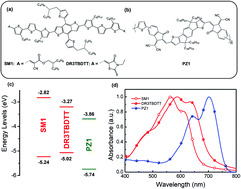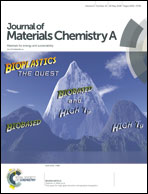High-efficiency organic solar cells based on a small-molecule donor and a low-bandgap polymer acceptor with strong absorption†
Abstract
Solution-processed organic solar cells (OSCs) have been attracting more and more attention for a series of well-known advantages, and power conversion efficiencies (PCEs) of over 11% have been reported. However, the highest PCE of the OSCs based on small molecule donor/polymer acceptor blends is only 4.82%, which was much lower than those of other types of OSCs due to weak absorption of the polymer acceptor and the unbalanced charge carrier mobility of the small molecule donor and the polymer acceptor. Here, we fabricated small molecule donor/polymer acceptor-based OSCs using the wide bandgap SM1 and DR3TBDTT as the small molecular donor and the low-bandgap n-type conjugated polymer PZ1 as the polymer acceptor. With the treatment of a solvent additive, which can promote the absorption intensity, enhance the carrier mobility and suppress the charge carrier recombination, the SM1-based devices and the DR3TBDTT-based devices show PCEs of 3.97% and 5.86%, respectively. It is worth mentioning that the PCE of 5.86% is the state-of-the-art efficiency for OSCs based on the small molecular donor/polymer acceptor system.



 Please wait while we load your content...
Please wait while we load your content...